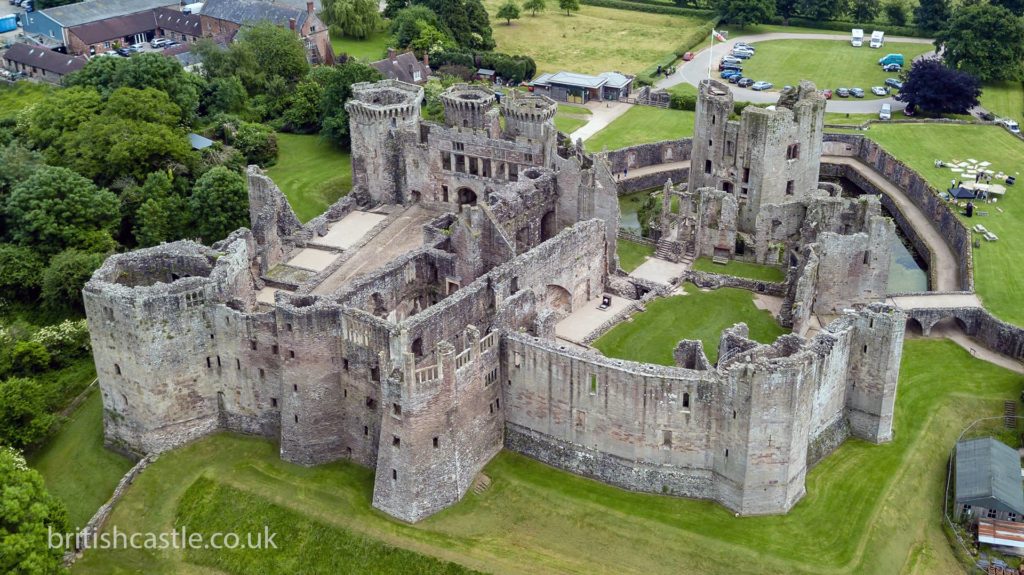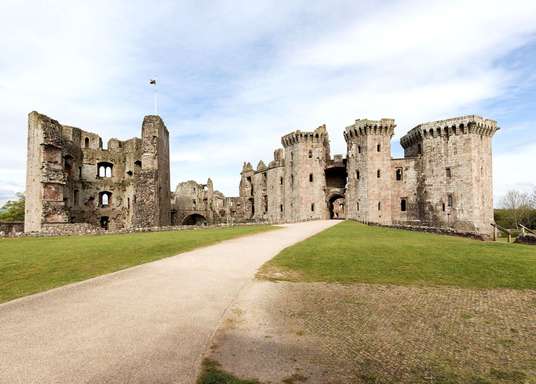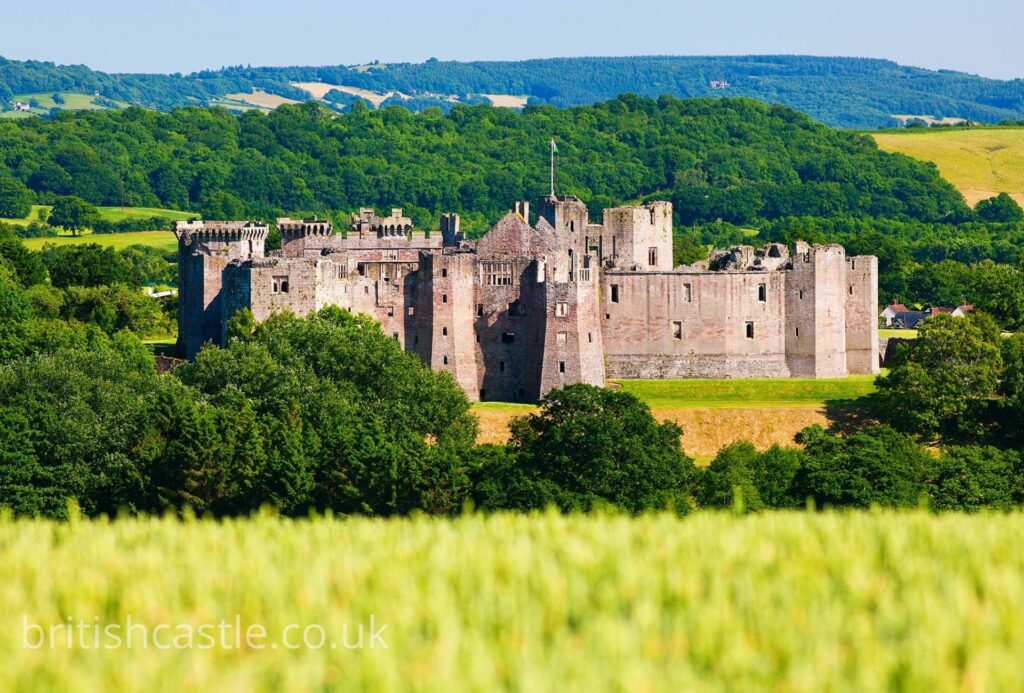Raglan Castle is a 15th century wonder in south Wales, near the lovely town of Raglan. Situated on a ridge in beautiful countryside, the castle is a picture perfect setting from the moment you arrive. Known as the grandest castle built by Welshmen, Raglan Castle is a testament to Wales’ rich history and heritage. Its Tudor styling and multi angled towers make it a must see for history buffs and architecture enthusiasts alike. Thousands of visitors come to this magnificent fortress every year to explore its history and architecture.
Raglan Castle was built on what would have been a motte and bailey Norman castle originally constructed by William Fitzherbert, and would have been a wooden building in the style commonly used by the invading Normans, following the architectural styles of northern France at the time. It is considered the grandest castle ever built by Welshmen.
The stone castle we see today was begun by Sir William ap Thomas. Sir William had fought alongside Henry V at Agincourt in 1415 and would have been granted lands and favours in return for his bravery and loyalty.

In 1435 he began work on building what we still see standing today, the Great Tower, complete with a moat. Unlike the massive castle building programme carried out throughout Wales to subdue the Welsh, Raglan Castle was constructed more as a statement of social standing and was meant to reflect the power and prestige of the owner. The moated Great Tower still dominates the fortress today.

Upon the death of Sir William, his son William Herbert, Earl of Pembroke, continued the building schedule planned by his father and added a massive gatehouse and also extended the castle borders to include accommodation slightly more comfortable than it would originally have been. The gatehouse was created with flared machicolations, a defensive architectural feature.
One of the last major additions to the castle was the Great Hall, built during the tenure of William Somerset, the Earl of Worcester during the late sixteenth century. Under various earls of Worcester, the castle was transformed into a magnificent country seat with a fashionable long gallery.
One of the features of Tudor architecture, apart from the Long Gallery, would have been large windows which you can still see the remnants of today.
By the seventeenth century Raglan Castle was in Royalist hands and was besieged by Parliamentary forces led by Sir Thomas Fairfax. Strong enough to withstand heavy bombardment the castle walls held for several weeks until the castle finally fell. During the siege, the castle housed a garrison of 800 men.

The trend for constructing huge castles as symbols of social status and nobility was rather falling out of fashion by the time of Cromwell’s attacks, it was more usual to build more sedate country mansions. Raglan Castle’s perceived ostentation may well have been one of the reasons for Cromwell’s sustained attack on it, and once Fairfax had seized the castle and evicted its owners he ordered the castle to be systematically demolished, or ‘slighted’. The strength of the walls prevented his destroying the castle in its entirety, and only two sides of the Great Tower came down despite repeated bombardment.
The castle was left to ruin, and sustained further demolition when the Duke of Beaufort took advantage of the crumbling stonework to use much of it when building his home in Badminton.
Today Raglan Castle is maintained by Cadw (Welsh Historic Monuments). For visitor information including opening times and ticket prices visit their website.
History of Raglan Castle
The story of Raglan Castle starts with Sir William ap Thomas, a seasoned French war veteran, who began building it around 1435. Ap Thomas, who made his fortune as a local agent for the Duke of York in south east Wales, wanted a castle that would reflect his status and power. The castle’s hexagonal plan and elaborate drawbridge arrangements are very French and unlike any other British castle.
After Sir William ap Thomas died his son William Herbert took over and developed the castle further. Herbert added the great gatehouse, the Pitched Stone Court and rebuilt the Fountain Court with formal state apartments to make the castle even grander. During the English Civil War the castle played a big part, with Henry, the new Earl and later Marquess of Worcester, investing his fortune in the royal cause. In 1646 the castle was besieged by Parliamentary forces under Sir Thomas Fairfax and in 1648 it fell. Cromwell’s demolition engineers soon got to work and reduced the walls to rubble.
Architecture
Raglan Castle’s architecture is the result of the combined efforts of Sir William ap Thomas and his son Sir William Herbert, Earl of Pembroke. The castle’s design features a moated Great Tower, also known as the Yellow Tower of Gwent, which is its most striking feature. This tower, started by Sir William ap Thomas, shows French influence and is a symbol of the castle’s defensive and palatial status.The architecture is enhanced by flared machicolations – stone arches that allowed defenders to rain missiles down on attackers. The Somerset family who added the final touches to the architecture contributed to the castle’s mix of defensive and aesthetic features. Visitors can see the fashionable long gallery and one of the best Renaissance gardens in Britain and Raglan Castle is a must see for historical architecture.
Visitor Info
Visitors to Raglan Castle are in for a treat as they explore the historic buildings including the Great Tower and the Pitched Stone Court. The visitor centre is a treasure trove of information with a piece of Tudor wooden panelling rescued from a cow shed proudly on display. This centre tells the story of the castle and its significance and gives a glimpse into its past.
The castle grounds are well equipped for a comfortable visit with car park, picnic benches and gift shop. Raglan Castle is also available for hire for events, filming and exhibitions and is a versatile venue. Educational visits can be booked through the Welsh Government and is a unique learning experience for students. For latest updates on opening times and weather check the castle’s social media or National Rail Enquiries for public transport information. The castle is near the town of Raglan and is easily accessible by car, bus or bike.
Preservation
Raglan Castle is a protected historic site and ongoing preservation work will ensure it is here for future generations. Managed by Cadw, the Welsh Government’s historic environment service, the historic buildings and grounds are carefully maintained. Visitors can support the preservation work by becoming a Cadw member and help protect and conserve this part of Wales’ heritage.
The Somerset family who have played a big part in the castle’s history still support its preservation. The looted treasures including the Tudor wooden panelling show the importance of the conservation work. The deliberate destruction of the castle during the Civil War highlights the need for continued work to preserve its historical significance and cultural importance. Through all this Raglan Castle remains a beloved landmark and a window into the past for all who visit.